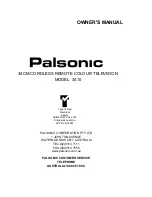
- 2 -
IMPORTANT SERVICE SAFETY INFORMATION
Operation of receiver outside of cabinet or with back removed involves
a shock hazard. Work on these models should only be performed by
those who are thoroughly familiar with precautions necessary when
working on high voltage equipment.
Exercise care when servicing this chassis with power applied. Many
B plus and high voltage RF terminals are exposed which, if carelessly
contacted, can cause serious shock or result in damage to the chassis.
Maintain connecting ground lead connections between chassis,
escutcheon, picture tube dag and tuner cluster when operating
chassis.
These receivers have a “Polarized” AC line cord. The AC plug is
designed to fit into standard AC outlets in one direction only. The
wide blade connects to the “ground side” and the narrow blade
connects to the “hot side” of the AC line. This assures that the TV
receiver is properly grounded to the house wiring. If an extension
cord must be used, make sure it is of the “polarized” type.
When it is necessary to make measurements or tests with AC power
applied to the receiver chassis, an Isolation Transformer must be used
as a safety precaution and to prevent possible damage to transistors.
The Isolation Transformer should be connected between the TV line
cord plug and the AC power outlet.
Certain HV failures can increase X-ray radiation. Receivers should
not be operated with HV levels exceeding the specified rating for their
chassis type. The maximum operating HV specified for the chassis
used in these receivers is 25 KV ± 1.0KV at zero beam current with a
line voltage of 120V AC. Higher voltage may also increase possibility
of failure in HV supply.
It is important to maintain specified values of all components in the
horizontal and high voltage circuits and anywhere else in the receiver
that could cause a rise in high voltage, or operating supply voltages.
No changes should be made to the original design of the receiver.
Components shown in the shaded areas on the schematic diagram
or identified by the safety mark in the replacement parts list should
be replaced only with exact Factory recommended replacement parts.
The use of unauthorized substitute parts may create shock, fire,
X-radiation or other hazard.
To determine the presence of high voltage, use an accurate high
impedance HV meter connected between second anode lead and
the CRT dag grounding device. When servicing the High Voltage
System remove static charge from it by connecting 10K ohm resistor
in series with an insulated wire (such as a test probe) between picture
tube dag and 2nd anode lead (AC line cord disconnected from AC
supply).
The picture tube used in this receiver employs integral implosion
protection. Replace with tube of the same type number for continued
safety. Do not lift picture tube by the neck. Handle the picture tube
only when wearing shatter-proof goggles and after discharging the
high voltage completely. Keep others without shatter-proof goggles
away.
When removing springs or spring mounting parts from tuner, tuner
cluster or chassis, shatter-proof goggles must be worn. Keep others
without shatter-proof goggles away.
SAFETY INSPECTION
Before returning the receiver to the user, perform the following safety
checks:
PROTECT YOUR CUSTOMER
1.
Inspect all lead dress to make certain that leads are not pinched
or that hardware is not lodged between the chassis and other
metal parts in the receiver.
2.
Replace all protective devices such as non-metallic control knobs,
insulating fishpapers, cabinet backs, adjustment and compart-
ment covers or shields, isolation resistor capacitor networks,
mechanical insulators, etc.
3.
To be sure that no shock hazard exists, a check for the presence
of leakage current should be made at each exposed metal part
having a return path to the chassis (antenna, cabinet metal, screw
heads, knobs and/or shafts, escutcheon, etc.) in the following
manner.
Plug the AC line cord directly into a 120V AC receptacle. (Do not use
an Isolation Transformer during these checks) All checks must be
repeated with the AC line cord plug connection reversed. (If necessary,
a non-polarized adapter plug must be used only for the purpose of
completing these checks.)
If available, measure current using an accurate leakage current tester.
(Use Standard Item No. 25086,21641) Any reading of 0.4 mA or more
is excessive and indicates a potential shock hazard which must be
corrected before returning the receiver to the owner.
If a reliable leakage current tester is not available, this alternate method
of measurement should be used. Using two clip leads, connect a 1500
ohm, 10 watt resistor paralleled by a 0.15 MF capacitor in series with
a known earth ground, such as a water pipe or conduit and the metal
part to be checked. Use a VTVM or VOM with 1000 ohms per volt, or
higher sensitivity to measure this AC voltage drop across the resistor.
Any reading of 0.61 volt RMS or more is excessive and indicates a
potential shock hazard which must be corrected before returning the
receiver to the owner.
X-RAY PROTECTOR CIRCUIT CHECK
PERFORM WHENEVER HIGH VOLTAGE CIRCUITRY OR POWER
SUPPLY CIRCUITRY IS SERVICED.
1.
Plug the AC Line Cord (P1) into a AC 120V, 60Hz receptacle.
2.
Turn the Power Switch (S101) on and wait for about 10 minutes.
3.
Connect the antenna leads to the EXT. Antenna Terminal (TE1)
and select a broadcasting station.
4.
Connect DC Digital Voltmeter to TP11 (positive lead) and TP4
(negative lead).
5. Apply DC 11V between TP11 and TP9 from external equipment.
6.
If picture and sound do not disappear, check IC301, D552, D553,
D554, R554, R555, R556, R557, C555 and C556.
AC
VOLTMETER
1500 OHMS
0.15 µF
TEST
PROBE
TO EXPOSED
METAL PARTS
TO KNOWN
EARTH GROUND
Содержание MT1191V
Страница 5: ...REMOTE CONTROL LAYOUT 4 VIDEO VIDEO ...
Страница 12: ...TEST POINT 11 ...
Страница 15: ...WIRING DIAGRAM 14 ...
Страница 17: ...P C BOARDS PCB 1 MAIN P C BOARD PCB 2 CRT SOCKET P C BOARD 16 ...
Страница 18: ...EXPLODED VIEW 16 142 158 ...




































